Active galactic nuclei are primarily powered by a supermassive black hole lying at the center of a host galaxy that is accreting matter from its vicinity. The radiation from the central source ionizes the inner dense gas, the so-called broad-line region. Using the Gemini Near-Infrared Spectrograph on the Gemini North telescope, one half of the International Gemini Observatory, operated by NSF’s NOIRLab, astronomers have detected two near-infrared emission lines associated with the broad-line region of the Seyfert 1 galaxy III Zw 002.

An artist’s impression of a supermassive black hole with an accretion disk orbiting it. The annotations show a hypothetical double-peaked profile with arrows indicating where in the broad line region each peak originates. Image credit: NOIRLab / NSF / AURA / P. Marenfeld.
“The Paschen-alpha (hydrogen) line originates in the inner region of the broad line region, and the O I (neutral oxygen) line originates in the outskirts of the broad line region, a region that has never been observed before,” said Denimara Dias dos Santos, a Ph.D. student at the Instituto Nacional de Pesquisas Espaciais.
“These are the first double-peaked profiles to be found in the near-infrared, and they emerged unexpectedly during observations with the Gemini Near-Infrared Spectrograph (GNIRS).”
“In 2003, observations of III Zw 002 in the visible revealed evidence of an accretion disk, and a 2012 study found similar results.”
In 2021, Rodriguez-Ardila and colleagues set out to supplement these findings with observations in the near-infrared using GNIRS, which is capable of observing the entire near-infrared spectrum (800-2500 nm) all in one go.
Because GNIRS is capable of making simultaneous observations across multiple bands of light, the team was able to capture a single clean, consistently calibrated spectrum in which multiple double-peaked profiles were revealed.
“We didn’t know previously that III Zw 002 had this double peaked profile, but when we reduced the data we saw the double peak very clearly,” Rodriguez-Ardila said.
“In fact, we reduced the data many times thinking it could be a mistake, but every time we saw the same exciting result.”
The observations not only confirm the theorized presence of an accretion disk, but also advance astronomer’s understanding of the broad line region.
“For the first time, the detection of such double peaked profiles puts firm constraints on the geometry of a region that is otherwise not possible to resolve,” Rodriguez-Ardila said.
“And we now have clear evidence of the feeding process and the inner structure of an active galaxy.”
By comparing these observations with existing disk models, the astronomers were able to extract parameters that provide a clearer picture of III Zw 002’s supermassive black hole and broad line region.
The model indicates that the Paschen-alpha line originates at a radius of 16.77 light-days, and the O I line originates at a radius of 18.86 light-days. It also predicts that the outer radius of the broad line region is 52.43 light-days.
The model also indicates that III Zw 002’s broad line region has an inclination angle of 18 degrees with respect to observers on Earth, and the supermassive black hole at its center is 400-900 million times the mass of our Sun.
“This discovery gives us valuable insights into the structure and behavior of the broad line region in this particular galaxy, shedding light on the fascinating phenomena happening around supermassive black holes in active galaxies,” Rodriguez-Ardila said.
The study was published in the Astrophysical Journal Letters.
_____
Denimara Dias dos Santos et al. 2023. First Observation of a Double-peaked O i Emission in the Near-infrared Spectrum of an Active Galaxy. ApJL 953, L3; doi: 10.3847/2041-8213/ace974







